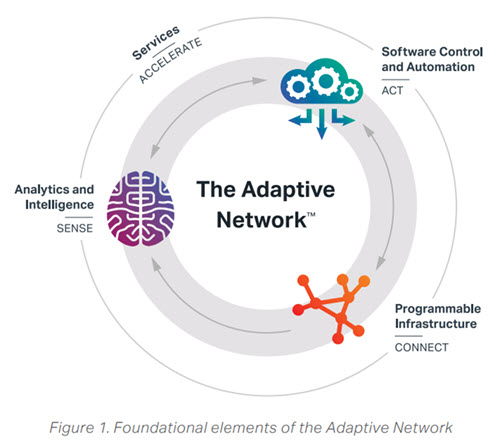3 network capabilities that agencies need to keep up with cyberthreats
Cybersecurity has always been a priority for government leaders, but today’s remote work environment is changing the security landscape. Now, government agencies are facing the challenge of securing and managing assets in the cloud while protecting exponential growth in network traffic across disparate locations.
Network termination points and traffic used to originate from office buildings and data centers but with COVID-19 forcing people to work from home, traffic has moved from commercial offices to residential networks served by the public internet, providing a larger attack surface for adversaries.
At the same time, low levels of automation, along with many manual processes in the network operations center, demand greater efforts to detect and mitigate security breaches. Unfortunately, traditional security techniques, such as firewalls and intrusion detection systems, no longer offer enough protection against today’s sophisticated threats, especially across a distributed work environment.
As malicious actors and cyberattacks continue to grow, agencies need to ensure they’re deploying the best possible lines of defense to keep data and systems safe. That security starts with the network — but not just any network. Here are the three key network capabilities needed to help agencies keep up with cyberthreats.
1. An Adaptive Network
At the core of Ciena’s Adaptive Network™ is a programmable infrastructure that ensures the continuous protection of all in-flight data. Once considered inherently secure, today’s in-flight data can easily fall victim to hackers with the expertise to tap into fibre optic connections. These cables are often easily accessible and unprotected, making them a target for capable adversaries. Even worse, a data breach from fibre hacking can occur without an agency even noticing for months or even years.
Fortunately, an Adaptive Network can respond to cyberthreats in real-time. For example, operators can dynamically re-configure a network to minimize the threat of a Denial-of-Service attack or move suspect traffic flows away from critical parts of the network when necessary. Better yet, an Adaptive Network with an extensible analytics platform and artificial intelligence capabilities can collect data to provide the deepest levels of actionable network insights, including potential security vulnerabilities.
Another security advantage of an Adaptive Network is greater visibility. For example, Ciena’s Blue Planet technology provides deep insights into the network that not only help to improve performance, but also enable government agencies to identify and react to potential cybersecurity attacks faster and more efficiently.
Blue Planet can tell a network operator about the health of the overall network, where traffic is flowing, and even if certain kinds of attack are under-way. This kind of flexible network not only helps to support different traffic flows but makes agencies more cyber-aware of their environments.
2. A Simplified Network via SDN
As cybersecurity threats become more sophisticated, government agencies are increasingly relying on a simplified network to secure critical assets. One way of accomplishing this is by shifting a network’s reliance on physical infrastructure to Software Defined Networking (SDN).
SDN bolsters network security in a number of ways. First, it allows for greater visibility into where traffic flows through the network. The result is greater network situational awareness, which allows government agencies to react faster and more effectively to potential cybersecurity attacks.
Another upside of SDN is its ability to make network management simpler. Managing a network is a labor-intensive activity that can distract IT teams from more mission-critical security tasks. However, SDN works as a “force multiplier” for network management and operations workforce, by enabling automation of rote tasks. And by allowing the underlying infrastructure to be abstracted and thus focused on applications and network services, SDN creates a more flexible, automated network that is easier and less time-consuming to manage.
Finally, by building security capabilities directly into key elements of the network rather than bolting them on, agencies can continuously monitor information flow, as well as identify any anomalous behavior of the network. In the case of military intelligence operations, for example, this improved visibility would restrict unauthorized users from transmitting or downloading information.
3. Optical-layer Encryption
Encryption technology has long protected data at rest, including data residing in databases, data center storage arrays and laptop hard drives. But ensuring government data remains private and secure requires a more robust solution: optical-layer encryption.
Technologies such as Transport Layer Security (TLS) and Secure Sockets Layer (SSL) can secure connections to servers. But Ciena’s WaveLogic™ Encryption, which encrypts in-flight data at the transport layer of the network, makes data undecipherable to any hacker who taps into fiber-optic cables. This is accomplished by camouflaging traffic so it cannot be read or manipulated, and even disguises the fact that there is traffic flowing at all.
Data is generally encrypted at the source, but many government customers want more protection. Fortunately, Ciena encrypts data at multiple layers, including at wire-speed across the network so that agencies are protecting the physical infrastructure itself. That way, if a hacker gets access to a node, the traffic in-flight is encrypted as well.
Together, these key capabilities — adaptiveness, SDN and encryption – enable government agencies to achieve greater network security in today’s cyber age. By combining always-on, high-capacity, wire-speed optical encryption with user authentication and intrusion-detection forensics, Ciena’s Adaptive Network offers protection of in-flight data from spying, in real time, all the time.
As a supplier of equipment and services to government agencies Ciena takes a comprehensive approach toward maintaining the security and continuity of its supply chain. Learn more.




